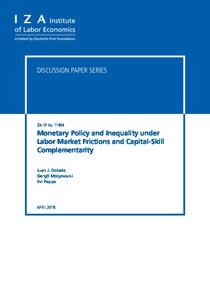Monetary policy and inequality under labor market frictions and capital-skill complementarity
"In order to improve our understanding of the channels through which monetary policy has distributional consequences, we build a New Keynesian model with incomplete asset markets, asymmetric search and matching (SAM) frictions across skilled and unskilled workers and, foremost, capital-skill co...
| Main Authors: | , , |
|---|---|
| Institution: | ETUI-European Trade Union Institute |
| Format: | TEXT |
| Language: | English |
| Published: |
Bonn
2018
IZA |
| Subjects: | |
| Online Access: | https://www.labourline.org/KENTIKA-19399181124911173639-Monetary-policy-and-inequality.htm |
| Summary: | "In order to improve our understanding of the channels through which monetary policy has distributional consequences, we build a New Keynesian model with incomplete asset markets, asymmetric search and matching (SAM) frictions across skilled and unskilled workers and, foremost, capital-skill complementarity (CSC) in the production function. Our main finding is that an unexpected monetary easing increases labor income inequality between high and low-skilled workers, and that the interaction between CSC and SAM asymmetry is crucial in delivering this result. The increase in labor demand driven by such a monetary shock leads to larger wage increases for high-skilled workers than for low-skilled workers, due to the smaller matching frictions of the former (SAM-asymmetry channel). Moreover, the increase in capital demand amplifies this wage divergence due to skilled workers being more complementary to capital than substitutable unskilled workers are (CSC channel). Strict inflation targeting is often the most successful rule in stabilizing measures of earnings inequality even in the presence of shocks which introduce a trade-off between stabilizing inflation and aggregate demand." |
|---|---|
| Physical Description: | 39 p. Digital |

